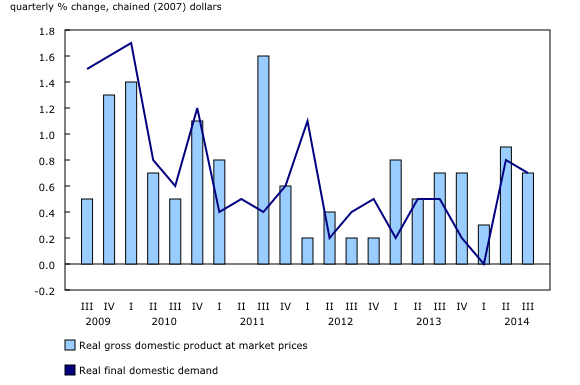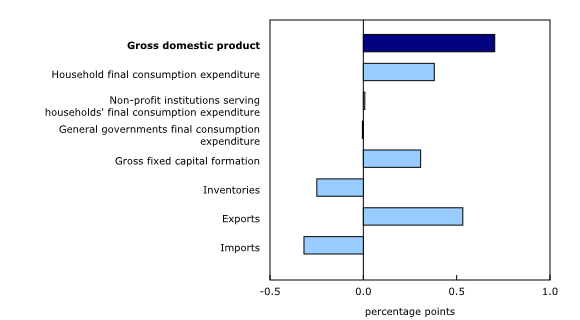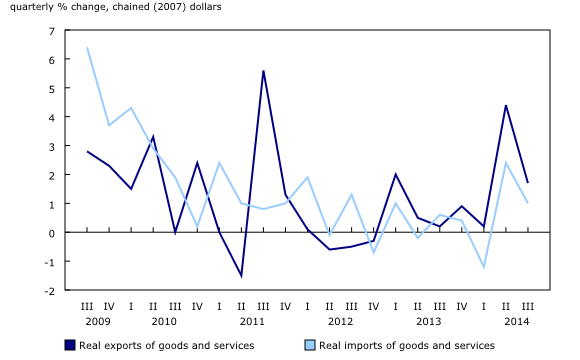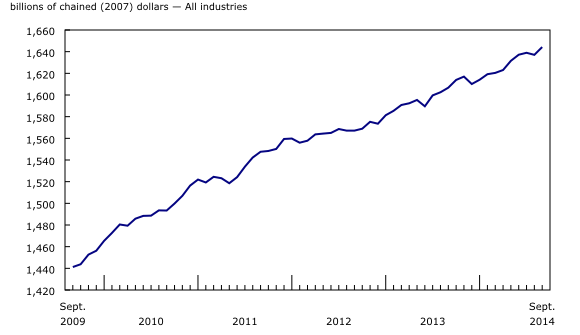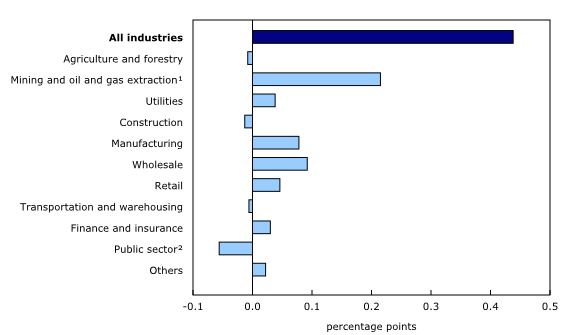Canadian economic accounts, third quarter 2014 and September 2014
Archived Content
Information identified as archived is provided for reference, research or recordkeeping purposes. It is not subject to the Government of Canada Web Standards and has not been altered or updated since it was archived. Please "contact us" to request a format other than those available.
Released: 2014-11-28
Real gross domestic product (GDP) rose 0.7% in the third quarter, following a 0.9% gain in the second quarter. On a monthly basis, real GDP by industry increased 0.4% in September.
The main contributors to GDP growth were exports of goods (+2.2%) and household final consumption expenditure (+0.7%). Business gross fixed capital formation (+1.5%) was also up. Final domestic demand rose 0.7% after increasing 0.8% in the previous quarter.
Household final consumption expenditure advanced in the third quarter as outlays on durable goods increased 3.0%. Semi-durable goods were also up while non-durable goods edged down. Expenditure on services slowed to 0.5%.
Business investment in residential structures rose 3.0%, the fastest pace since the first quarter of 2012. Ownership transfer costs (+7.3%), an indicator of resale activity, and new home construction (+2.3%) were the main contributors to the growth. Business investment in non-residential structures, machinery and equipment edged up 0.1%.
Exports of goods and services advanced 1.7% after increasing 4.4% in the second quarter. Imports rose 1.0% despite a 1.4% decline in imports of services.
The value added of service industries grew 0.8% in the third quarter. There were notable gains in wholesale and retail trade, finance and insurance services, at offices of real estate agents and brokers and in professional services. Increases were also recorded in the public sector (education, health and public administration combined), transportation and warehousing services as well as accommodation and food services.
The output of goods-producing industries edged up 0.1% in the third quarter. Notable gains in manufacturing and construction were mostly offset by declines in the agriculture and forestry, mining and oil and gas extraction, and utilities sectors.
Expressed at an annualized rate, real GDP expanded 2.8% in the third quarter. By comparison, real GDP in the United States rose 3.9%.
Household spending continues to increase
Household final consumption expenditure advanced 0.7% in the third quarter, a slower pace than in the second quarter (+1.1%). Consumers increased spending on goods by 0.9%, led by durable goods (+3.0%), whereas spending on services grew 0.5% following a stronger second quarter.
Transport purchases (+2.1%) contributed the most to the growth in household final consumption, boosted by a 4.6% increase in purchases of vehicles.
Outlays on housing, water, electricity, gas and other fuels (+0.5%), recreation and culture (+1.0%) and furnishings, household equipment and other goods and services (+1.1%) also contributed to the growth in household spending.
Expenditures by Canadians abroad fell 0.1%, following a 0.7% increase in the second quarter.
Housing demand up
The third quarter was marked by particularly strong business investment in residential structures (+3.0%), the fastest pace since the first quarter of 2012. Ownership transfer costs (+7.3%), new construction (+2.3%) and renovations (+1.5%) all contributed to growth in the housing sector.
Increased business investment in plant and equipment
Business investment in non-residential structures, machinery and equipment grew 0.1% in the third quarter, following a 0.2% increase in the second quarter.
Business investment in non-residential structures decreased 0.5% after edging up 0.1% in the second quarter. This was the third decline in four quarters.
Investment in machinery and equipment picked up 1.3%, as outlays on medium and heavy trucks, buses and other motor vehicles increased 6.5%.
Investment in intellectual property products up
After two negative quarters, business outlays on intellectual property products grew a robust 3.8% in the third quarter.
Investment in mineral exploration and evaluation increased 8.7% after falling 17.5% in the previous quarter. Investment in research and development was up 3.3% whereas investment in software grew 2.2%.
Deceleration in business inventory accumulation continues
Businesses added $624 million in inventories in the third quarter, after accumulating $4.8 billion in the second quarter. Inventory accumulation has slowed throughout 2014.
Retail trade increased inventories by $1.1 billion, after drawing down inventories by $663 million in the previous quarter. Wholesalers accumulated $2.5 billion in inventories, down from $8.2 billion in the previous quarter.
Manufacturers slightly drew down on their inventories for the second straight quarter (-$298 million). Farm inventories fell by $3.0 billion, as farmers reduced their inventories for a third consecutive quarter.
Exports remain strong
Exports of goods and services rose 1.7% in the third quarter, following a strong 4.4% increase in the second quarter.
Exports of goods advanced 2.2%, with intermediate metal products (+6.7%), crude oil and crude bitumen (+2.2%) and basic chemicals and industrial chemical products (+10.0%) contributing to the increase. Exports of passenger cars and light trucks rose 2.2%, following a 10.8% advance in the previous quarter.
Exports of services were down 1.0%, as commercial services declined 2.3%.
Imports increase
Imports of goods and services rose 1.0% after advancing 2.4% in the second quarter. Growth was driven by increased imports of goods (+1.5%).
Imports of crude oil and crude bitumen (+14.1%) and refined petroleum energy products (+16.8%) contributed to the increase in imports of goods.
Imports of services decreased 1.4%, mostly because of a decline in imports of commercial services (-1.9%). Imports of travel (-1.3%) and transportation (-0.3%) services were also down.
Economy-wide income grows
Nominal GDP rose 1.1% in the third quarter, up slightly from the 1.0% gain in the second quarter.
Compensation of employees increased 1.0%, following a 0.6% gain in the second quarter. Wages and salaries were up in the goods-producing (+1.2%) and service-producing (+0.9%) industries.
The gross operating surplus of financial corporations grew 8.8%, following a 5.0% gain in the second quarter. The gross operating surplus of non-financial corporations was up 1.1%. Overall, the gross operating surplus of corporations rose 1.7%.
Household saving rate unchanged
The household saving rate remained at a four-year low in the third quarter, at 3.9%.
The household debt service ratio, defined as household mortgage and non-mortgage interest paid divided by disposable income, was 6.88%, its lowest level on record.
The national savings rate was 6.0% for the third quarter, up from 5.5% in the second quarter. National disposable income advanced 1.4%, slightly above the pace recorded in the previous quarter.
Terms of trade narrows
Terms of trade for Canada worsened for a second quarter in a row, limiting growth in real gross domestic income to 0.7%.
Exports and imports prices declined 0.5% and 0.4%, respectively. The overall price of goods and services produced in Canada rose 0.4%, following a 0.1% increase in the second quarter.
The price of final domestic demand increased 0.4%, the same pace as in the second quarter.
Gross domestic product by industry, September 2014
Real gross domestic product rose 0.4% in September, after declining 0.1% in August.
The output of goods-producing industries grew 1.0% in September, mainly as a result of increases in mining and oil and gas extraction and, to a lesser degree, manufacturing. Utilities also advanced. In contrast, construction and the agriculture and forestry sector contracted.
The output of service industries grew 0.2% in September, largely as a result of gains in wholesale and retail trade as well as the finance and insurance sector. Declines were recorded in the public sector (education, health and public administration combined), and to a lesser extent, in transportation and warehousing services as well as the arts and entertainment sector.
Mining, quarrying and oil and gas extraction expanded 2.5% in September, following declines of 1.8% in August and 1.4% in July. Oil and gas extraction grew 3.6% in September as a result of higher oil production, following maintenance activities in August. Mining and quarrying (excluding oil and gas extraction) increased 0.6%, mainly as a result of gains in non-metallic mineral and coal mining. The growth was partly offset by a notable decline in copper, nickel, lead and zinc mining. Support activities for mining and oil and gas extraction rose 0.7% as a result of an increase in drilling services.
Wholesale trade advanced 1.7% in September, with increases in most trade groups. Notable gains were recorded in the wholesaling of building materials and supplies as well as machinery, equipment and supplies. In contrast, the wholesaling of farm products and, to a lesser extent, petroleum products declined in September. Retail trade rose 0.9%, mainly as a result of increased activity at motor vehicle and parts dealers.
Manufacturing output increased 0.8% in September, after declining 1.3% in August. Durable-goods manufacturing rose 1.6% as most major industrial groups recorded growth. Gains were notable in transportation equipment and machinery manufacturing. On the other hand, the manufacturing of fabricated metal products declined. Non-durable goods manufacturing decreased 0.3%, pulled down by a notable decline in petroleum and coal products. Conversely, food manufacturing was up in September.
The public sector decreased 0.3% in September, mainly as a result of the decline in educational services. Educational services fell 1.0% in September, mainly as a result of a labour dispute in British Columbia. Overall, public administration as well as health care and social assistance services were unchanged in September.
Construction decreased 0.2%, as both non-residential and residential building construction declined. The output of real estate agents and brokers fell 0.6% in September.
The finance and insurance sector increased 0.5% in September, a fourth consecutive monthly increase. Growth in banking services more than offset the slight declines in financial investment and insurance services.
The transportation and warehousing services edged down 0.1%, mainly as a result of a decrease in rail transportation.
The agriculture and forestry sector decreased 0.5%, largely as a result of lower crop production.
Utilities increased 1.7% in September. Electric power generation, transmission and distribution advanced, along with natural gas distribution.
Products, services and contact information
Detailed analysis and tables
The System of macroeconomic accounts module, accessible from the Browse by key resource module of our website, features an up-to-date portrait of national and provincial economies and their structure.
Links to other releases from the national accounts can be found in the third quarter 2014 issue of Canadian Economic Accounts Quarterly Review, Vol. 13, no. 3 (Catalogue number13-010-X). This publication is now available from the Browse by key resource module of our website under Publications. This publication will be updated on November 28, at the time of the release of the national balance sheet and financial flow accounts.
Note to readers
The Canadian System of macroeconomic accounts has implemented a new revision policy. Annual revisions, which affect the three most recent calendar years, took place on November 5, rather than in May, as was previously the practice. For more information see Latest Developments in the Canadian Economic Accounts (Catalogue number13-605-X).
For more information on seasonal adjustment, see Seasonally adjusted data — Frequently asked questions.
Percentage changes for expenditure-based and industry-based statistics (such as personal expenditures, investment, exports, imports and output) are calculated from volume measures that are adjusted for price variations. Percentage changes for income-based and flow-of-funds statistics (such as labour income, corporate profits, mortgage borrowing and total funds raised) are calculated from nominal values; that is, they are not adjusted for price variations.
There are four ways of expressing growth rates for gross domestic product (GDP) and other time series found in this release.
1. Unless otherwise stated, the growth rates of all quarterly data in this release represent the percentage change in the series from one quarter to the next, such as from the second quarter to the third quarter of 2014.
2. Quarterly growth can be expressed at an annual rate by using a compound growth formula, similar to the way in which a monthly interest rate can be expressed at an annual rate. Expressing growth at an annual rate facilitates comparisons with official GDP statistics from the United States. Both the quarterly growth rate and the annualized quarterly growth rate should be interpreted as an indication of the latest trend in GDP.
3. The year-over-year growth rate is the percentage change in GDP from a given quarter in one year to the same quarter one year later, such as from the third quarter of 2013 to the third quarter of 2014.
4. The growth rates of all monthly data in this article represent the percentage change in the series from one month to the next, such as from August to September 2014.
With this release of monthly gross domestic product by industry, the data incorporate the new 2011 input-output annual benchmarks, revised source data, improved methodologies and revised seasonal adjustment factors. As a result, the monthly series have been revised back to January 2010.
Data on gross domestic product by industry for October will be released on December 23.
Products
Data on gross domestic product for the third quarter has been released along with revised data for the first and second quarters. These data incorporate new and revised source data and updated data on seasonal patterns.
Data on gross domestic product by income and by expenditure for the fourth quarter of 2014 will be released on March 3, 2015. For more information, consult the Guide to the Income and Expenditure Accounts (Catalogue number13-017-X).
Contact information
For more information, or to order data, contact us (toll-free 1-800-263-1136; 514-283-8300; infostats@statcan.gc.ca).
To enquire about the concepts, methods or data quality of this release, contact Allan Tomas (613-951-9277), Industry Accounts Division.
- Date modified:


